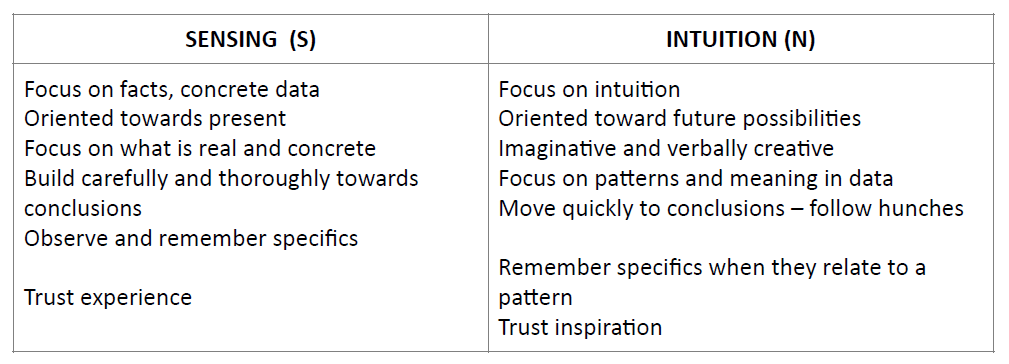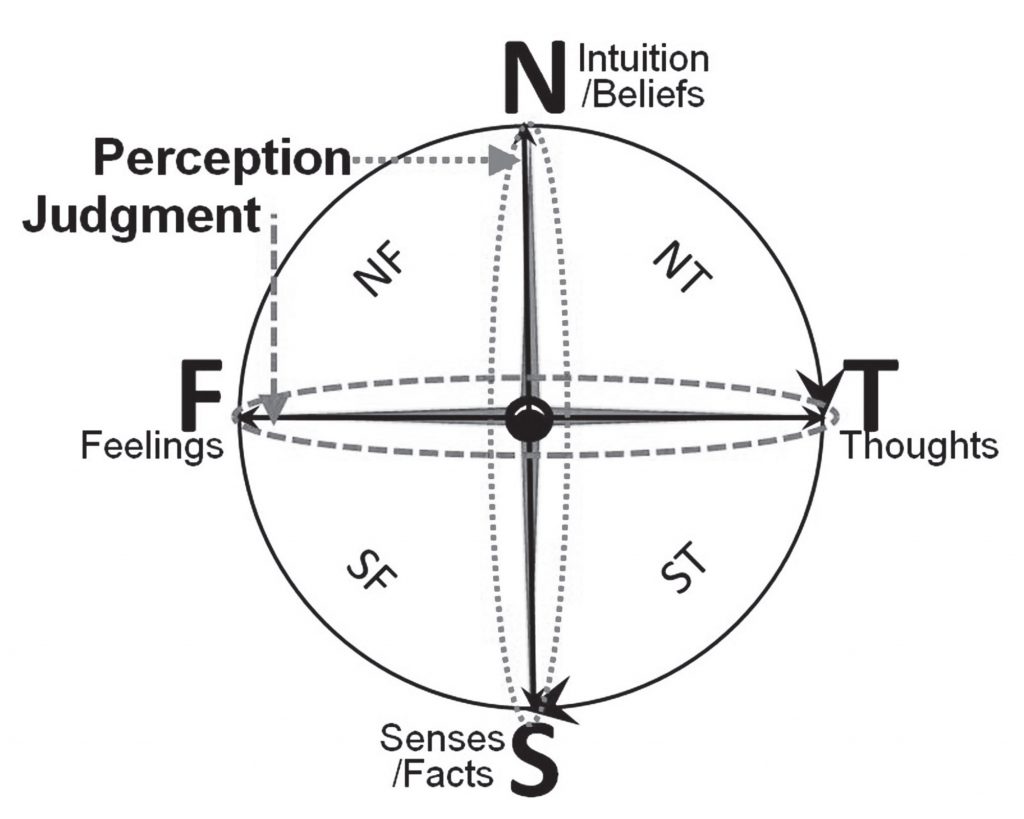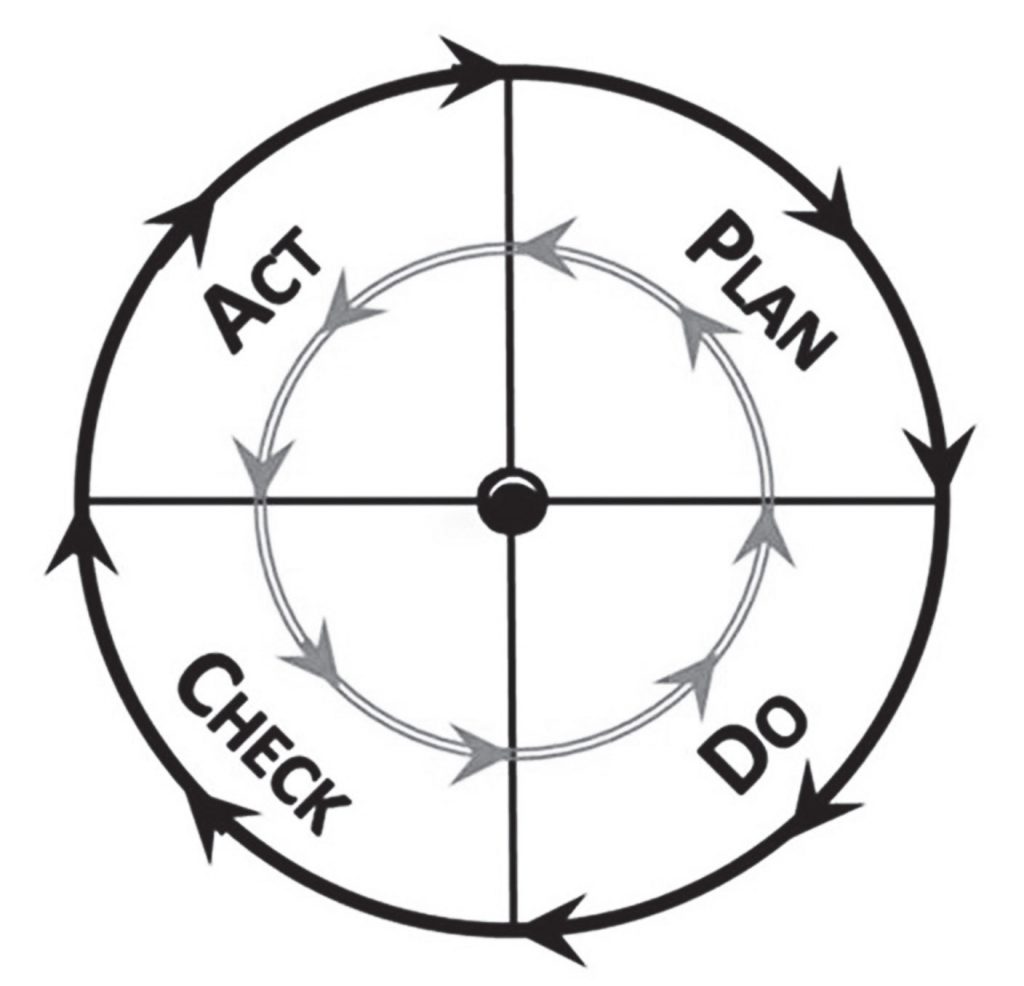THEORETICAL FOUNDATION OF THE AUTHENTICITY COMPASS (AC)
To understand the AC, you must understand the supporting frameworks that define this tool.
They are:
• the Perception-Judgment (PJ) mental function framework based on Carl Jung’s work
• the PDCA Cycle of Success behavioral framework based on the work of Edwards Deming
PJ Framework and the Work of Jung
When people’s minds are engaged, they are involved in two fundamental brain activities:
- taking in information, perceiving
- organizing that information and coming to conclusions, judging
Jung (1875-1961) identified two ways people perceive (i.e.take in information) which he called sensing and intuition; and two ways people judge (i.e. organize information and draw conclusions) which he called thinking and feeling.
While these mental processes are available to and used by everyone, research has shown that people are innately different in what they prefer, leading them to develop different personality traits and behavior patterns/habits.
To understand what is meant by innate preference consider handwriting. If you were asked to write your full name using your non dominant hand, how difficult would it be? For most people the response would be “challenging”. This is not to say it could not be done but that your preferred approach would be to use your dominant hand because it is natural and easy to do. Handwriting provides a straighforward demonstration of innate preference.
Now, let’s turn back to our discussion of mental function activities.
Listed below are some of the characteristics and differences between how people with a preference for sensing and people with a preference for intuition take in information:

For example, if you ask an individual with the sensing preference to describe an apple, they might say it is: red, shiny, has a sticker on it, etc. – they would describe it in concrete, observable terms. On the other hand, an individual with an intuition preference might say it is delicious, used to make pies, etc. – he/she sees and identifies the possibilities for the apple versus focusing on its concrete observable characteristics. Listed below are some of the characteristics and differences between how people with a preference for thinking and people with a preference for feeling make decisions:

Here is an example of decision-making that highlights the use of different judgment preferences. Let’s say a little league team was going to play in the World Series. Given the expense of travel, the coach has to limit how many team members he can take. The coach with a preference for thinking, would identify criteria to help him/her choose – for example, he might look at stats, such as RBI’s. On the other hand, a coach with a feeling preference might choose a player whose family’s financial situation does not allow them to take trips, regardless of his stats, in order to give that player the opportunity of a travel experience.
The AC combines each of the perception preferences (S or N) with each of the judgment preferences (T or F) to form perception judgment (PJ) pairs:
• ST = Sensing-thinking
• SF =Sensing-feeling
• NT = Intuition – thinking
• NF – Intuition-feeling
These 4 combinations comprise the 4 quadrants of the PJ Framework depicted below:

It is essential to understand that perception and judgment are always employed by the brain in perception-judgment pairs. This means that every time you take in information (perceive something), your brain also processes it (makes a judgment or conclusion about it). So, when you interact in the world, you are always using 1 of the 4 PJ pairs. For example, if you are caring for a baby, chances are you will be using your sensing-feeling PJ pair (SF). Likewise, if you are paying your bills, you are probably in a practical, results-oriented mode and will most likely employ your sensing-thinking PJ pair (ST). So while your brain employs only one PJ pair at a time, achieving success and happiness in life requires knowing how to make use of all four PJ pairs. Therefore, it is in your best interest to develop skills that support each pair.
Every day, we are asked to take action and make decisions. Well-informed decisions take into consideration facts (S), beliefs (N), thoughts (T), and feelings (F). That is to say they access and utilize all four AC quadrants. However, what makes you unique is that you have a dominant PJ pair that you rely on more than the others. So, even though you may believe you use your senses and intuition equally to form your perceptions, it is not likely. The same is true regarding how you form your judgments. Even though you might think you are using your thinking and feeling functions equally to make decisions, it is not likely. Such self-awareness of how you uniquely take in information and process it is critical to successfully navigating all domains of your life.
Your preferred PJ pair is your dominant quadrant (DQ). It can be considered your “True North”. Just as sailors keep track of the North Star for navigational purposes, the same holds true regarding you having awareness of your DQ. Why? Your DQ represents your typical “go to” energy. However, given the different circumstances and people you face in life you cannot rely solely on your DQ. Your effectiveness and success require knowing when another PJ pair is more appropriate, and having the necessary skills to employ it. In other words, you must develop fluidity in your use of PJ energy. Fluidity requires skill development; skill development that supports each one of the four PJ pairs. Without attention to skill development you are at risk for certain people and situations making you feel “out of balance” and mis-aligned.
PDCA Cycle of Success (Deming’s work)
Edwards Deming (1900-1993) was an American statistician who taught Japanese engineers after World War II how to produce high-quality goods without expensive machinery. By applying his techniques, Japanese businesses like Toyota, Fuji, and Sony experienced great success. In 1982 Deming wrote the book “Out of the Crisis” to help the US successfully compete with Japan.
Central to Deming’s teachings is what he called “The Cycle of Success”. This cycle is comprised of four interdependent activities that when effectively aligned and supported result in the successful outcome of all processes to which it is applied … no matter whether the process is personal (such as losing weight) or business-oriented (such as strengthening sales). These four activities are: planning, execution, monitoring and inspiring change:
- Planning drives execution.
- Execution produces the “deliverables”.
- Monitoring identifies what must be changed.
- Skills that inspire / motivate self (and, when required, others) to make the changes the monitoring effort identified.
- The plan is revised and the cycle repeats ….until no longer needed.

Pulling it all together: the Authenticity Compass
By connecting the perception-judgment and PDCA frameworks , you get your Authenticity Compass. (Please examine the tab “Creating and Understanding Your Authenticity Compass”) Your Authenticity Compass guides you to:
- be true to yourself by understanding and utilizing your unique preferences and skills as evidenced by your DQ and by developing the skills you need to live a life defined by alignment and balance (authenticity)
- recognize when you need to develop the skills and behaviors of a less dominant AC quadrant OR when you need to further develop your DQ skills (balance)
- recognize the conscious choices you must make to achieve success in your interactions with diverse individuals and in the varied circumstances of your life (alignment)
